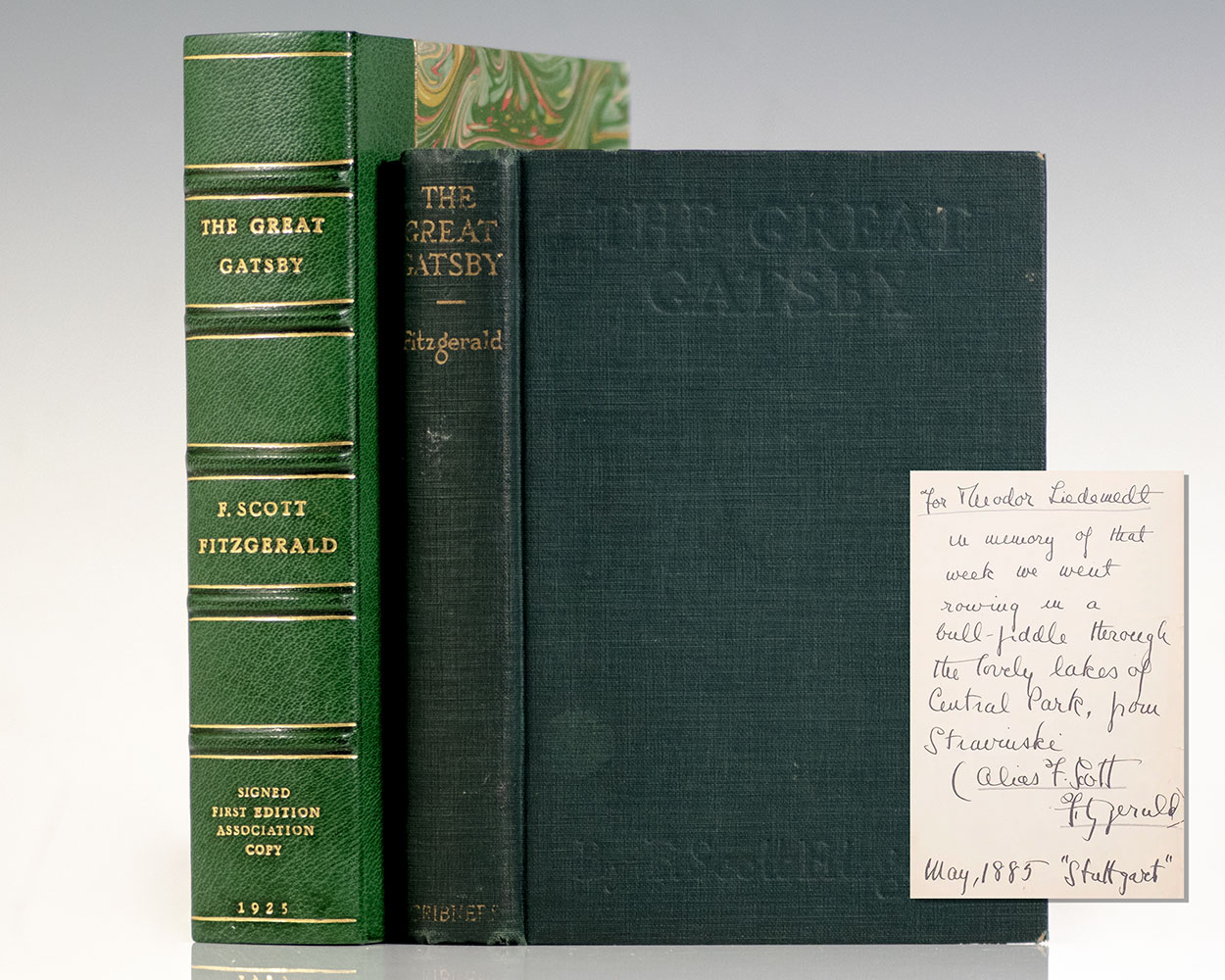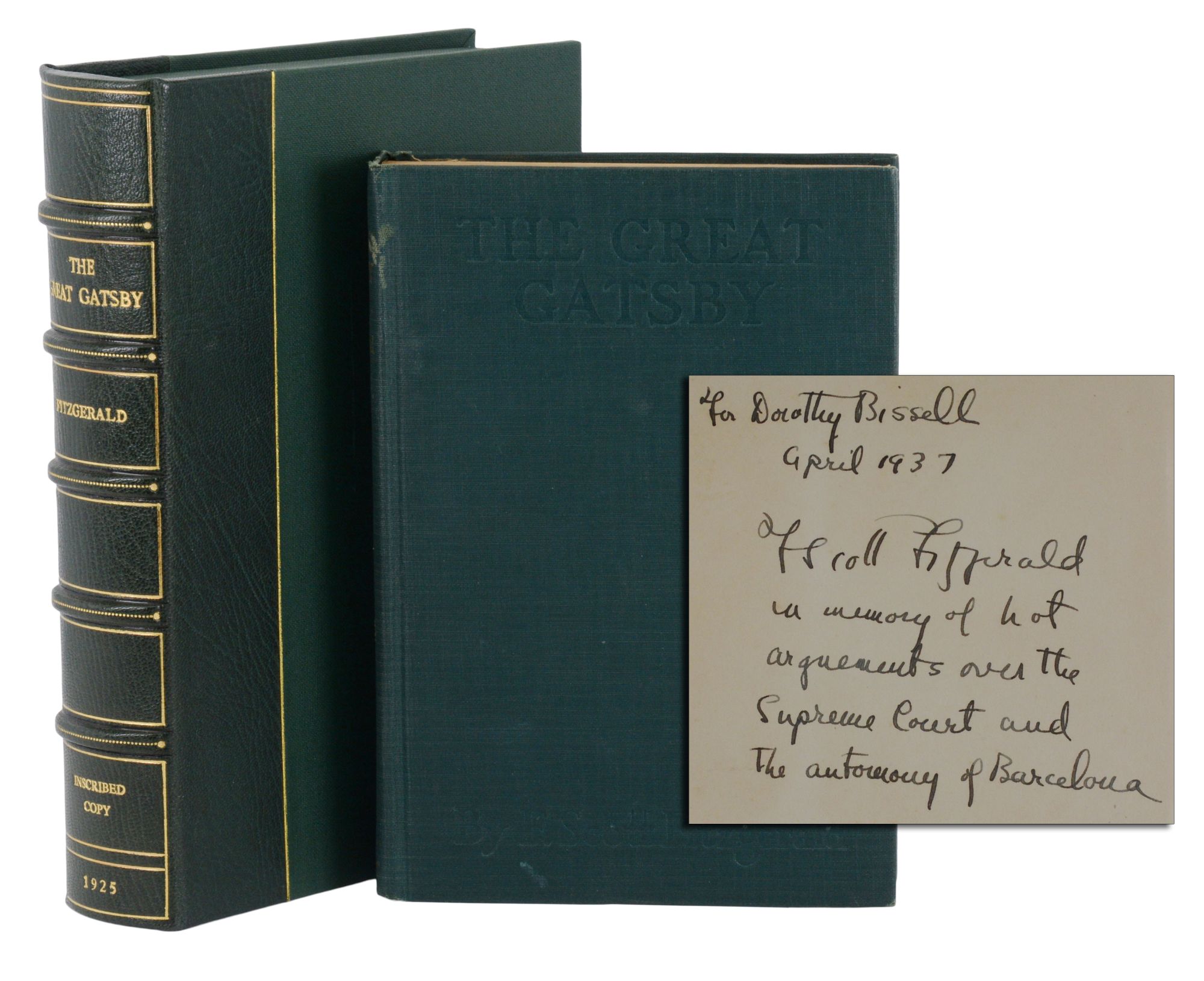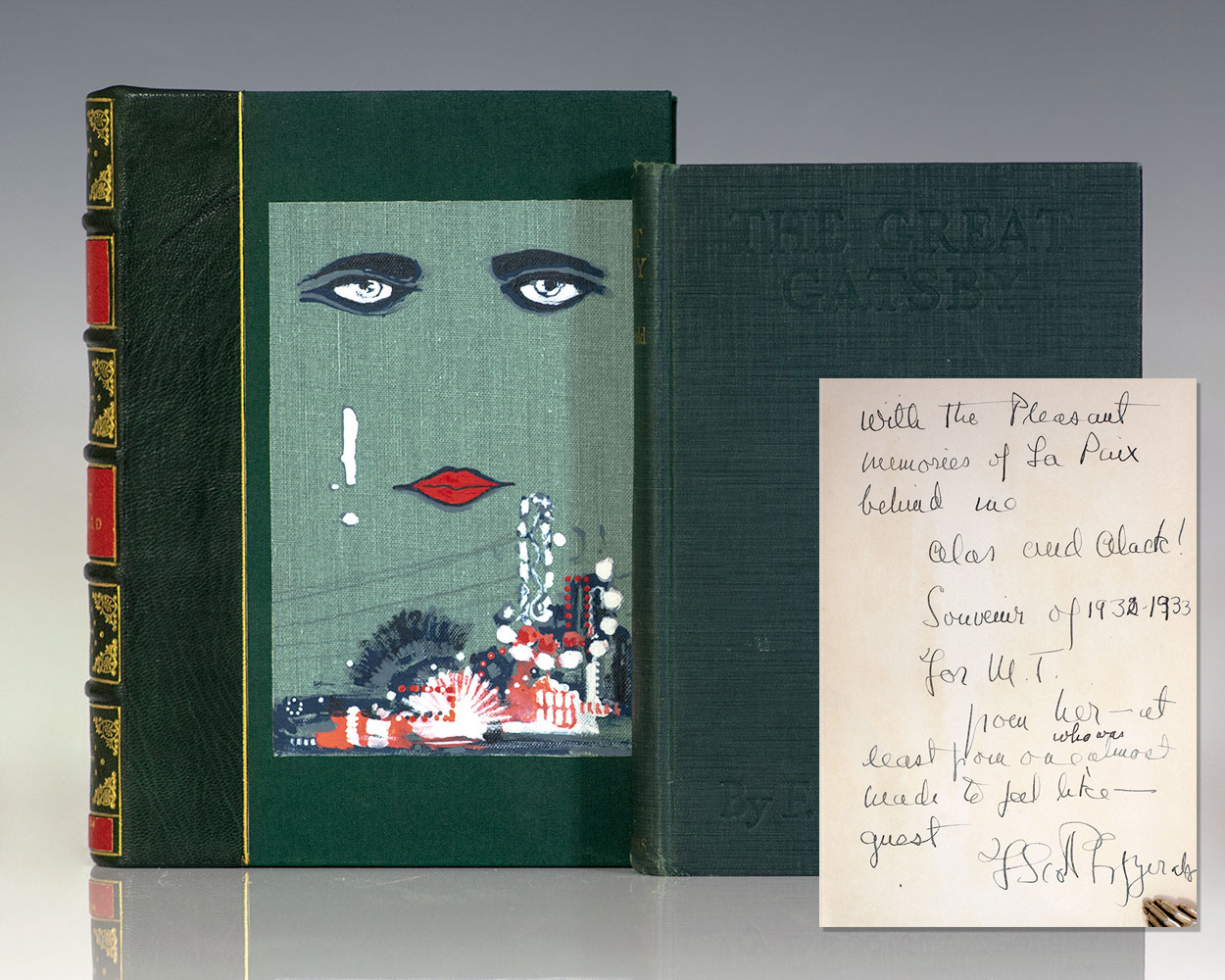Available Copies from Independent Booksellers

Fitzgerald, F. Scott. The Great Gatsby.. Charles Scribner's Sons, New York, 1925.
Price: US$200000.00 + shipping
Description: First edition, second issue of Fitzgerald's masterpiece with all six second issue points present, including: âecholaliaâ on page 60, âsouthernâ on page 119, âsickantiredâ on page 205, and âUnion Stationâ on page 211. Octavo, original dark green cloth with gilt titles to the spine. Presentation copy, lengthily inscribed by the author on the front free endpaper, "For Theodore L. Liedemedt in memory of that week we went rowing in a bull-fiddle through the lovely lakes of Central Park, from Stravinski (Alias F. Scott Fitzgerald) May 1885 'Stuttgart.'" The recipient, Theodore L. Liedemedt, was a German-born musician and close personal friend of Fitzgerald's. Kept in Liedemedtâs family for over ninety years, family lore has it that the two first met on board a transatlantic ship crossing in the 1920s (Fitzgerald traveled to Europe in 1921, 1924, 1928, and 1929). Liedemedt was a working musician who performed on some of those crossings. He died in 1929, just making it to 30. Fitzgerald, older only by three years, just outlived his friend, dying in 1940 at 44. A South New Jerseyian in the later part of his short life, Liedemedt arrived on American shores in 1915 during the First World War. He worked first on the crew of a German merchantman, interned in the Delaware River, then from June 1916 at a day job in Philadelphia. When the United States entered the First World War officially on April 6, 1917, Liedemedt was detained by the FBI on April 7. He was released a few days later when they found that he did not hare the political convictions of his home country and was, therefore, not a threat to the United States. Fitzgerald took up residence in New Jersey in in 1911 when he attended the Newman School, a Catholic prep school in Hackensack. After graduating he attending Princeton University, only a few miles from Liedemedtâs stomping grounds, where Fitzgerald abruptly left in 1917 to join the American Army. Having avoided active service in Europe he moved to New York City where he would begin his career as a writer. Fitzgerald and Liedemedt were never more than roughly 80 miles from each other, from Liedemedtâs landing in 1915 to his early death 14 years later. The nature of the inscriptionâ"knowing, familiar, full of inside referencesâ"points to an intimacy not documented in an other sources in Fitzgeraldâs archives. In very good condition. Housed in a custom half morocco clamshell box made by the Harcourt Bindery. An exceptional inscription from Fitzgerald. In 1922, Fitzgerald announced his decision to write "something new--something extraordinary and beautiful and simple and intricately patterned." That extraordinary, beautiful, intricately patterned, and above all, simple novel became The Great Gatsby, arguably Fitzgerald's finest work and certainly the book for which he is best known. A portrait of the Jazz Age in all of its decadence and excess, Gatsby captured the spirit of the author's generation and earned itself a permanent place in American mythology. Cyril Connolly called The Great Gatsby one of the half dozen best American novels: "Gatsby remains a prose poem of delight and sadness which has by now introduced two generations to the romance of America, as Huckleberry Finn and Leaves of Grass introduced those before it" (Modern Movement 48). Consistently gaining popularity after World War II, the novel became an important part of American high school curricula. Today it is widely considered to be a literary classic and a contender for the title "Great American Novel". In 1998, the Modern Library editorial board voted it the 20th century's best American novel and second best English-language novel of the same time period. It was the basis for numerous stage and film adaptations. Gatsby had four film adaptations, with two exceptionally big-budget versions: the 1974 version starring Robert Redford and Mia Farrow, as well as Baz Luhrmannâs 2013 version starring Leonardo DiCaprio, Tobey Maguire and Carrie Mulligan. Fitzgeraldâs granddaughter praised Lurhmannâs adaptation, stating âScott would be proud.â Second printing, with âecholaliaâ on p. 60, ânorthernâ for âsouthernâ on p. 119, âsickantiredâ on p. 205, and âUnion Street stationâ for âUnion Stationâ on p. 211.
Seller: Raptis Rare Books, Palm Beach, FL, U.S.A.

Fitzgerald, F. Scott. The Great Gatsby. Charles Scribner's Sons, New York, 1925.
Price: US$200000.00 + shipping
Condition: Very Good
Description: First edition, second printing, one of 3,000 copies, with all six textual errors from the first printing corrected. Signed by F. Scott Fitzgerald and inscribed "For Dorothy Bissell, April 1937, F. Scott Fitzgerald, in memory of hot arguments over the Supreme Court and the autonomy of Barcelona." Bound in publisher's original dark green cloth with spine lettered in gilt and upper board in blind; lacking the scarce dust jacket; housed in a custom chemise case. Very Good with a few abrasions to the cloth most notably at the spine, a patch of slight discoloration along the top edge of the rear cover, light occasional foxing throughout. Signed copies of the author's best-known work are scarce and desirable. This copy was auctioned by Christie's in 1983, and again in 1994. In 1983 it was sold alongside copies of This Side of Paradise and The Beautiful and the Damned, also inscribed by Fitzgerald to Dorothy Bissell in a rather playful manner and dated April, 1937. During April, 1937, Fitzgerald was living at the Oak Hall Hotel in Tyron, North Carolina while Zelda was in Highland Hospital in nearby Asheville. He was heavily in debt, often drunk, and his career was at a standstill; he would embark for Hollywood in June. Brucolli A 11.1.b.
Seller: Burnside Rare Books, ABAA, Portland, OR, U.S.A.

Fitzgerald, F. Scott. The Great Gatsby.. Charles Scribner's Sons, New York, 1925.
Price: US$250000.00 + shipping
Description: Octavo, original dark green cloth with gilt titles to the spine. Association copy, inscribed by the author on the front free endpaper, âWith the Pleasant memories of La Paix behind me alas and alack! Souvenir of 1932â"1933 for M.T. from her â" at least from one who was almost made to feel like â" a guest. F. Scott Fitzgerald.â The recipient, Margaret Turnbull, who with her husband Bayard owned La Paix, a 28â"acre estate with a large Victorian house near Towson, Maryland. The Fitzgeralds rented La Paix from the Turnbulls in 1932 and 1933 because of its proximity to the Phipps Clinic, the psychiatric branch of Johns Hopkins, where Zelda was being treated. This is also where Fitzgerald finished work on his second masterpiece, Tender is the Night. The Turnbulls lived nearby in another house on the estate; while Bayard Turnbull disapproved of Fitzgerald, his wife Martha shared an interest in literature with him and became a good friend of him. According to her son, at their first dinner together âFitzgerald grew heated on the subject of Thomas Wolfe and left the table to get his copy of âLook Homeward, Angelâ, which he insisted my mother take with her and read at once⦠Out of such treads their friendship was woven. Each time they met here was a carryâ"over from the previous meeting â" something to discuss that seemed of vital importance⦠He was constantly lending my mother books: Proust, D.H. Lawrence, Hemingway, Rilke, the diary of Otto Braun⦠My mother became for a brief season a listener to and therefore a sharer of his thoughtsâ (Turnbull, Scott Fitzgerald, pp. 221â"240). It was Margaret Turnbull who introduced Fitzgerald to T.S. Eliot when the poet was staying with her family while lecturing at Johns Hopkins on the Metaphysical Poets. Bruccoli A11.1.b; Connolly, The Modern Movement 48. In near fine condition with the spine gilt exceptionally bright. First edition, second printing with "sickantired" on page 205, most inscribed copies are second printings. Housed in a custom half morocco clamshell box. An exceptional association, most rare and desirable. In 1922, Fitzgerald announced his decision to write "something new--something extraordinary and beautiful and simple and intricately patterned." That extraordinary, beautiful, intricately patterned, and above all, simple novel became The Great Gatsby, arguably Fitzgerald's finest work and certainly the book for which he is best known. A portrait of the Jazz Age in all of its decadence and excess, Gatsby captured the spirit of the author's generation and earned itself a permanent place in American mythology. Cyril Connolly called The Great Gatsby one of the half dozen best American novels: "Gatsby remains a prose poem of delight and sadness which has by now introduced two generations to the romance of America, as Huckleberry Finn and Leaves of Grass introduced those before it" (Modern Movement 48). Consistently gaining popularity after World War II, the novel became an important part of American high school curricula. Today it is widely considered to be a literary classic and a contender for the title "Great American Novel". In 1998, the Modern Library editorial board voted it the 20th century's best American novel and second best English-language novel of the same time period. It was the basis for numerous stage and film adaptations. Gatsby had four film adaptations, with two exceptionally big-budget versions: the 1974 version starring Robert Redford and Mia Farrow, as well as Baz Luhrmannâs 2013 version starring Leonardo DiCaprio, Tobey Maguire and Carrie Mulligan. Fitzgeraldâs granddaughter praised Lurhmannâs adaptation, stating âScott would be proud.â Second printing, with âecholaliaâ on p. 60, ânorthernâ for âsouthernâ on p. 119, âsickantiredâ on p. 205, and âUnion Street stationâ for âUnion Stationâ on p. 211.
Seller: Raptis Rare Books, Palm Beach, FL, U.S.A.